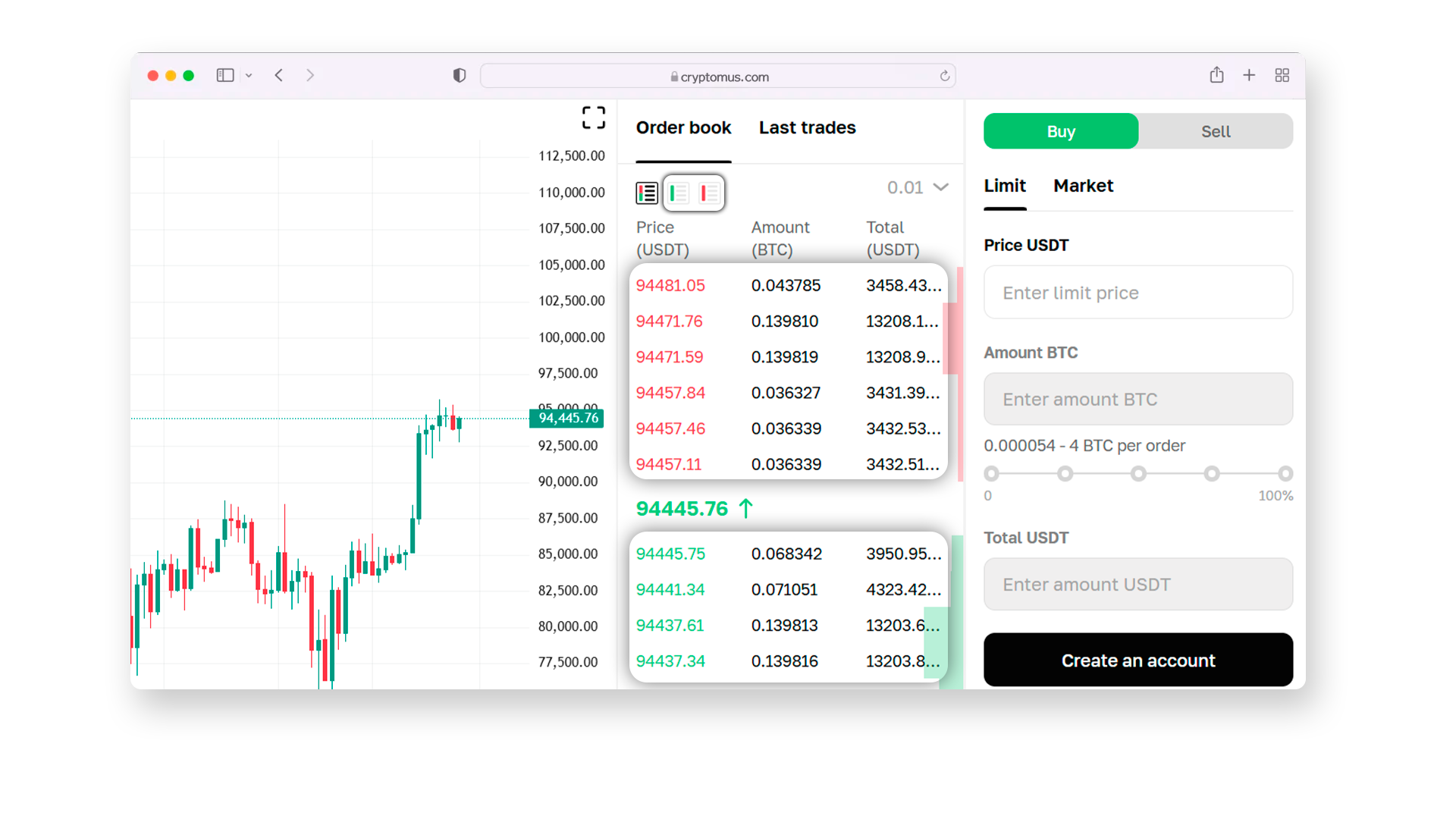
What Is An Order Book?
Are you interested in trading crypto but don't know what an order book is? In this article, we will tell you in detail about this financial tool, which will help you to confidently navigate the mood of the crypto market, open trades in time, and increase profits.
What Is The Meaning Of An Order Book?
An order book is an electronic list of all active buy (bids) and sell (asks) limit orders for a certain asset, sorted by price. You can see the volume of buy and sell orders at each price level, revealing market demand and potential price movements. Simply put, this is a tool that displays the market participants’ intentions: who is willing to buy or sell an asset, at what price, and in what quantity. This chart not only records the participants' intentions but also shows the real-time “temperature” of the market, helping traders understand supply and demand and make better-informed decisions.
Order books are available on almost every crypto exchange. For example, on Cryptomus in spot trading, you can also see the order book, divided into two parts by colors: asks are highlighted in red at the top, and bids are shown in green at the bottom. You can also choose to view only asks or only bids, depending on your needs.
How Does the Order Book Work?
To understand how the order book works, imagine a constantly changing flow of orders. Every time a trader places a buy or sell limit order, it appears in the book. If there is an opposing order at the same time, the orders match automatically, and the trade is executed. If there are no matches, the order remains in the list and waits for the market to “meet” it.
The order book updates in real time. Any action taken by participants—whether it’s placing a new order, changing the price, or canceling an order—immediately reflects in the structure. If you're a buyer, your limit order will be added based on the price you're willing to pay. If you're a seller, it will be added based on the price you're willing to accept. In this way, the order book constantly shows the current balance of power between sellers and buyers.
It's important to understand that only market orders move the order book. Unlike limit ones, which simply "sit" in the list until they are matched, market orders are executed immediately at the best available prices. For example, if a trader wants to sell 4 SUI at market price and the order book contains buy orders for 2 SUI at $3 and another 2 SUI at $2.5, the market order will "consume" both levels — as a result, the trader will sell 2 SUI at $3 each and 2 SUI at $2.5 each, receiving a total of $11. This process shifts the next available price, as the market order clears out existing limit orders.
In high-liquidity markets, the movement of the order book can be rapid, while on less liquid assets, changes occur more slowly.
Key Parts Of The Order Book
To effectively use the order book in trading, it is important to understand its key components and how they interact with each other. We have prepared a list of the key elements for you:

-
Bid Side—these are orders to buy an asset with the price highlighted in green. They reflect the demand: the higher the bid price, the higher the willingness of market participants to buy the asset. They are usually listed in descending order from the highest to the lowest price.
-
Ask Side—these are orders to sell an asset with the price highlighted in red. They reflect the supply in the market: the lower the ask price, the more willing sellers are to sell the asset. They are listed in ascending order from the lowest to the highest price.
-
Spread—it is the difference between the highest bid price and the lowest ask price. The spread indicates market liquidity: the smaller the spread, the more liquid the market is.
-
Top of the order book—it is the area of the order book where the highest buy orders and the lowest sell orders are currently placed. These orders are typically executed first, as they are closest to the current market price.
-
Amount—it is the total quantity of the asset that market participants are willing to buy or sell at a certain price. For example, if ten traders each want to buy two Bitcoin at the same price, the total amount would be 20 BTC.
-
Total—it is the value of the transaction in monetary terms, such as USDT. It is calculated by multiplying the amount of the asset by the order price. In our example, buying 20 BTC at 94,000 USDT each would mean a total value of 1,880,000 USDT. It is important to note that the numbers can change depending on the market rates.
Understanding these key components of the order book allows traders to more accurately interpret market data, make informed trading decisions, and effectively manage their positions in the market.

How To Read The Order Book?
Follow these tips to read an order book:
-
Identify the sides: start by distinguishing between the bid side (buy orders) and the ask side (sell orders). A trader’s job is to monitor both sides and understand where the main market interest lies.
-
Check price levels and amounts: each order book level represents the price at which participants are willing to buy or sell an asset and the amount at that price. The larger the quantity, the greater the liquidity and interest in that price level.
-
Analyze the spread: it reflects the difference between the most favorable buy and sell prices. As mentioned earlier, a narrower spread usually indicates a more liquid market, while a wider spread may indicate less liquidity or potential price volatility.
-
Watch the order flow: observe the dynamics of changes in the order book over time. Look for signs such as an increase or decrease in orders at specific price levels. Paying attention to these changes allows you to gauge market sentiment and predict possible price fluctuations.
-
Monitor the impact of trades: pay attention to how trades affect the order book. When trades occur, orders are executed and the corresponding volumes are removed from the book. Analysis can provide insight into possible price movements.
-
Compare with other indicators: using the order book in combination with other analysis tools, such as price charts and technical indicators, helps to get a more complete picture of the market. This addition allows you to make more informed trading decisions by taking into account additional factors.
So, by correctly interpreting and utilizing order book data, traders can gain a significant advantage in the market and choose the right moment to execute their trades.
How To Use The Order Book In Trading?
Proper use of the order book in trading can significantly enhance the efficiency of trading. Here are some strategies that traders can use the order book for:
-
Liquidity analysis: exchanges with a large number of orders reflect a high level of liquidity, which makes buying and selling much easier without significant price volatility. On the other hand, if an exchange has an order book with a small number of orders, it indicates low liquidity and potential difficulties in buying or selling the asset.
-
Identifying support and resistance levels: large buy orders indicate strong support, while large sell orders signal resistance at that price level.
-
Predicting market movement: traders often analyze the number of unfilled orders at different price levels to predict potential market fluctuations.
Thus, we can say that an order book is a valuable tool to understand supply and demand in the crypto markets. For a trader, the order book becomes an indispensable assistant in trading: it helps to minimize risks, find optimal entry and exit points, and adapt to rapidly changing market conditions. Mastering order book skills opens the path to more stable and profitable trading in any market situation.
Was this article useful for you? Write about it in the comments and stay with the Cryptomus blog to become more crypto-educated!
Rate the article








comments
0
You must be logged in to post a comment